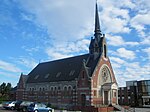The Battle of Lens (20 August 1648) was a French victory under Louis II de Bourbon, Prince de Condé against the Spanish army under Archduke Leopold Wilhelm in the Thirty Years' War (1618–1648). It was the last major battle of the war and a French victory. The battle cemented the reputation of Condé as one of the greatest generals of his age.
Over the four years following the decisive French victory at Rocroi against the Spanish Army of Flanders, the French captured dozens of towns throughout northern France and the Spanish Netherlands. Archduke Leopold Wilhelm was appointed governor of the Spanish Netherlands in 1647 to strengthen Spain's Habsburg alliance with Austria, and began a major counteroffensive the same year. The Spanish army first found success recapturing the fortresses of Armentières, Comines and Landrecies.
The Prince de Condé was recalled from a failed campaign in Catalonia against the Spanish and appointed commander of the 16,000-man French army opposite the Spanish army of the Archduke and General Jean de Beck, the governor of Luxembourg. Condé captured Ypres but then the 18,000-strong Spanish-German force laid siege to Lens. Condé advanced to meet them.
In the battle that ensued, Condé provoked the Spanish into giving up a strong hilltop position for an open plain, where he used the discipline and superior close-combat capabilities of his cavalry to charge and rout the Walloon-Lorrainer cavalry on the Spanish wings. The French infantry and cavalry in the center were attacked by the strong Spanish center, suffering heavy losses but holding their ground. The French cavalry on the wings, freed from any opposition, encircled and charged the Spanish center, who promptly capitulated. The Spanish lost half their army, some 8,000–9,000 men of which 3,000 were killed or wounded and 5,000–6,000 captured, 38 guns, 100 flags along with their pontoons and baggage. French losses were 1,500 killed and wounded. The French victory contributed to the signing of the Peace of Westphalia but the outbreak of the Fronde rebellion prevented the French from exploiting their victory to the hilt against the Spanish.








